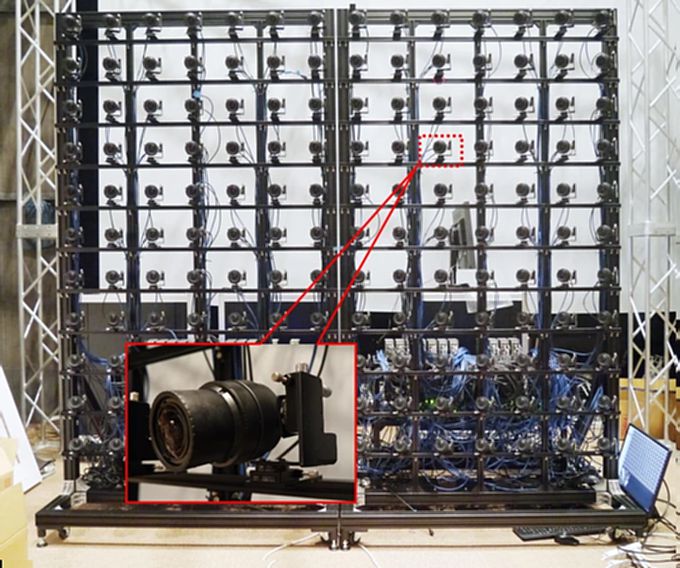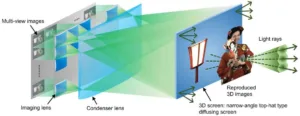A team of researchers headed by Hayato Watanabe within the Science and Technology Research Laboratories at NHK (Tokyo, Japan) is developing a novel lightfield based 3D TV system. The display is reported as producing an image that has both horizontal and vertical parallax and does so with reduced crosstalk as compared to other lightfield approaches. The system is called Aktina Vision.

An interesting point to note is that the word aktina derives from the Greek word “aktina” meaning ray of light.
A recent article by the team on this topic is entitled “Aktina Vision: Full-parallax three-dimensional display with 100 million light rays.” It was published in Scientific Reports volume 9, Article number: 17688 (2019). A copy of the article is available on line and can be found here.
In this article, the researchers describe prior art lightfield based displays as producing 3D imagery with inadequate quality for commercial TV applications. One problem identified with prior art lightfield displays is that high quality image reproduction requires numerous light rays and that the number of light rays in these systems had been insufficient. In fact, NHK has previously reported on an earlier version of the Aktina system and acknowledges that it suffered from the related issue of inadequate resolution. The current research at NHK focused on addressing this issue.
First, a few words of background information on the operation of a generic lightfield display system. On the image capture side of the system, an array of video cameras is used to capture multi-viewpoint images of a scene from both horizontal and vertical locations. On the display side of the system, optics are used to shift and multiplex the light rays to produce a 3D image by reproducing the light rays from the scene. The Aktina Vision lightfield display system is built on these basic principles. A graphic explaining the display side of the Aktina Vision system is presented in the figure below.
Basic principle of the display side of the Aktina Vision lightfield display system. An optical image of the scene is reconstructed by projecting multi-view images having both horizontal and vertical parallax at a narrow angle interval onto the 3D screen and optimally diffusing light rays with a 3D screen.
Consider first the system used to acquire the light rays of real, moving objects. The researchers developed an array composed of 14 video cameras in the horizontal direction and 11 video cameras in the vertical direction for a total of 154 video cameras. Each video camera had a resolution of 1920?x?1080 pixels. A photograph of the video camera array is presented in the figure below.
 The video camera array used to capture the lightfield of a scene.
The video camera array used to capture the lightfield of a scene.
The prototype display system developed to produce the image included fourteen 4K (3840?x?2160 pixel) resolution projectors arranged in parallel. Each projector displayed multi-view images consisting of 25 viewpoints, 5 horizontal and 5 vertical each with a resolution of 768?x?432 pixels. It follows that the fourteen projectors project a total of 350 viewpoints onto the 3D screen. Multiply the number of viewpoints by the resolution of each viewpoint and it is seen that the lightfield is reconstructed with over 100,000,000 light rays.
Each multi-view image is enlarged and projected onto the 3D screen through an imaging lens and a condenser lens. Most significantly, the projectors were positioned close together so that the gaps between the multi-view images could be minimized.
Consider some of the details of the 3D screen used in the Aktina Vision display. It has isotropic top-hat diffusion characteristics and a narrow diffusion angle of approximately 1.0°. This is important because, by setting diffusion characteristics to top-hat shape rather than the general Gaussian shape, the spatial resolution characteristics could be enhanced thus further minimizing the gaps between light rays and reducing the amount of crosstalk.
A screen with the desired characteristics was achieved by fabricating a hexagonal array of micro-lens on the surface of the screen. At 170 ?m, the lenses are smaller than the pixel size of the projected image. The first step in the fabrication of the lenses utilizes a UV curable resin. The next step uses a UV curable resin made of another material to fill in the surface. This second resin is then cured. By optimally selecting the UV curable resin materials to adjust the difference in refractive index between the lenses and their fillings it is possible to control the diffusion angle.
The researchers also reported the need to adjust the displayed 3D images by geometrically correcting the multi-view images projected by each projector in an offline process. Other characteristics of the system include a horizontal viewing angle of 35.1°, a vertical viewing angle of 4.7° and a 3D video frame rate of 60 fps.
The technical article discusses the means used to evaluate the 3D imagery produced by the prototype Aktina Vision display system. The results are also reported in the article and include the significant point that “3D images without distortion could be observed independent of the viewing distance and viewer’s posture.”
A video containing a demonstration of the Aktina Vision system is available on-line. It is listed as video 1 in the Supplementary Information section on the web page that can be found here.
Although projectors were used as display devices in the prototype system, the researchers intend to develop a thinner display system by using a flat panel liquid crystal or OLED display. -Arthur Berman

